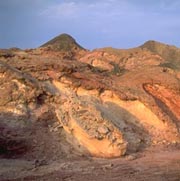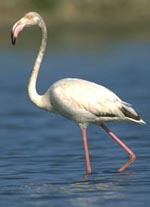 The island of Sir Bani Yas, off the coast of Abu Dhabi near Jebel Dhanna, is dominated by cone-shaped central 'mountains' surrounded by gently sloping coastal plains. These merge with a shoreline of mangrove covered sand-banks and hidden inlets, buttressed foreshore and finally a well constructed small harbour. Thanks to the personal vision and dedication of HH Sheikh Zayed bin Sultan Al Nahyan, much of the island has been transformed from arid desert into a peaceful and verdant haven for a wide range of wildlife. Visitors to the island are immediately impressed by both the quantity and variety of birds and animals. The island of Sir Bani Yas, off the coast of Abu Dhabi near Jebel Dhanna, is dominated by cone-shaped central 'mountains' surrounded by gently sloping coastal plains. These merge with a shoreline of mangrove covered sand-banks and hidden inlets, buttressed foreshore and finally a well constructed small harbour. Thanks to the personal vision and dedication of HH Sheikh Zayed bin Sultan Al Nahyan, much of the island has been transformed from arid desert into a peaceful and verdant haven for a wide range of wildlife. Visitors to the island are immediately impressed by both the quantity and variety of birds and animals.  Huge herds of both Arabian gazelle (Gazella gazella) and rheem or sand gazelle (Gazella subgutturosa) roam freely. Significant numbers of Arabian oryx (Oryx leucoryx) enjoy the freedom of a large enclosure of several square kilometres where natural breeding has resulted in an ever-increasing population of this species that, only a few years ago. was on the brink of extinction. In addition to Arabian indigenous species, there are numerous African species, such as Beisa oryx, addax, eland, blackbuck and scimitar-horned oryx, which enjoy the freedom and protection afforded by the island's luxuriant environment. Huge herds of both Arabian gazelle (Gazella gazella) and rheem or sand gazelle (Gazella subgutturosa) roam freely. Significant numbers of Arabian oryx (Oryx leucoryx) enjoy the freedom of a large enclosure of several square kilometres where natural breeding has resulted in an ever-increasing population of this species that, only a few years ago. was on the brink of extinction. In addition to Arabian indigenous species, there are numerous African species, such as Beisa oryx, addax, eland, blackbuck and scimitar-horned oryx, which enjoy the freedom and protection afforded by the island's luxuriant environment.
 In addition to the many mammals, the island also plays host to many migratory and resident bird species. Greater flamingos (Phoenicopterus ruber) congregate in colourful groups among the coastal lagoons, along with numerous smaller species that enjoy the shelter of the mangroves. A man-made lake attracts a variety of ducks and waders, while enormous flocks of sea birds use the shores of Sir Bani Yas as a welcome resting place during long migratory flights. Other species, such as the ubiquitous bulbul, large colonies of doves and partridge are also present in abundance. At the island's feeding stations, flocks of helmeted guinea fowl may be seen feeding alongside gazelle and deer species, while majestic peacock enjoy the shade of hedgerows surrounding the 'pastures'. In addition to the many mammals, the island also plays host to many migratory and resident bird species. Greater flamingos (Phoenicopterus ruber) congregate in colourful groups among the coastal lagoons, along with numerous smaller species that enjoy the shelter of the mangroves. A man-made lake attracts a variety of ducks and waders, while enormous flocks of sea birds use the shores of Sir Bani Yas as a welcome resting place during long migratory flights. Other species, such as the ubiquitous bulbul, large colonies of doves and partridge are also present in abundance. At the island's feeding stations, flocks of helmeted guinea fowl may be seen feeding alongside gazelle and deer species, while majestic peacock enjoy the shade of hedgerows surrounding the 'pastures'. 
Large areas featuring serried ranks of carefully tended trees attract colourful moths and butterflies, such as the blue pansy (Precis orithya) and other attractive insects. Orchard plantations are an example of the imaginative projects successfully undertaken by Sheikh Zayed to turn this desert island into an island oasis of abundance and natural beauty. Apples, oranges, pears and olives flourish here, showing how sustained effort can turn even the most inhospitable habitat into a green and productive environment.
|